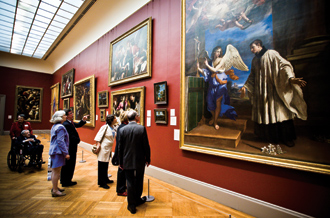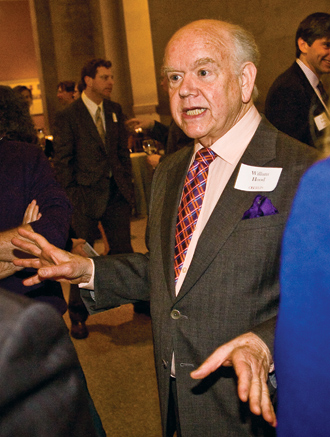Oberlin Alumni Magazine
Summer-Fall 2010 Vol. 105 No. 4
In a New Light
Pairing works from the Allen Memorial Art Museum with those of the Met and the Phillips brings new insight to all three collections
 Visitors view works at New York’s Metropolitan Museum of Art during the opening of Side by Side: Oberlin’s Masterworks at the Met.
Visitors view works at New York’s Metropolitan Museum of Art during the opening of Side by Side: Oberlin’s Masterworks at the Met.
Equipped with folded maps bearing colorful notations, the Oberlin alumni and friends setting out into New York’s sprawling Metropolitan Museum of Art on an unseasonably balmy March evening appeared to be on some sort of scavenger hunt.
But the treasures they were seeking—paintings and sculptures on loan from the Allen Memorial Art Museum—weren’t exactly hidden. They were, in fact, in plain sight, embedded into the Met’s permanent collection in an innovative exhibit called Side by Side: Oberlin’s Masterworks at the Met, which was on view in New York City for six months.
Many others beyond the Oberlin community embarked upon the same quest in the months that followed the gala opening of the show, at which more than 500 alumni and other guests gathered. They were richly rewarded with juxtapositions that allowed for fresh interpretations of works from both collections. Critics, including those from the New York Times and the Wall Street Journal, gave high praise to the pairings. The Times even suggested that the Oberlin works could provide some direction for visitors navigating the Met’s enormous collection. “It helps,” the Times’ Ken Johnson added, “that almost every Oberlin piece is something the Met would probably love to own.”
While the Allen routinely loans art to other museums, the combination of quantity and quality made this exhibit a standout, even for a museum accustomed to blockbuster shows. What made it possible—besides the collaboration between the staffs of the Allen, the Met, and Washington, D.C.’s Phillips Collection, where a similar show opened in September—was the fact that renovations have required the Allen to be shuttered for 18 months (it will reopen in late 2011).
When the Allen is open, staff is committed to having the best works available for Oberlin students, faculty, and the community, but the renovation provided a rare opportunity to let the collection’s masterworks travel together, making it more attractive to big-name museums and their big-city clientele.
“We knew that the renovation would be the last chance for a very long time to have a core group of our best works travel together and be seen as a group by audiences far from Oberlin,” says Allen director Stephanie Wiles, who organized the show with Andria Derstine, the Allen’s curator of collections and curator of European and American art, and Maryan Ainsworth ’71, curator of European paintings at the Met.
Wiles says she and Derstine thought New York and Washington were perfect locations to take the Oberlin collection because Oberlin has large alumni bases in both cities. Both cities also offered top-notch museums with which to collaborate.
“The Met was a natural because, of course, it’s the Met,” says Derstine. “But the Met also has an important Hendrick ter Brugghen painting that we knew would be fascinating to pair with Oberlin’s St. Sebastian Tended by Irene by ter Brugghen, a painting universally recognized as one of the most important northern baroque paintings in America.”
To begin the process of choosing works, Wiles and Derstine drew up a list they thought would make excellent pairings with the Met and Phillips’ collections. At the Met, they met with curators in the European paintings department, including Ainsworth.
“In some cases there were side-by-side pairings to create new conversations with works by the same artists,” says Wiles. “In other cases, Oberlin’s works added new voices to the Met’s collection. For example, the Met has no paintings or sculpture by [Ernst Ludwig] Kirchner.” The Allen lent one of each to the Met.
To provide additional insight into the works, Derstine, along with Mildred C. Jay Professor of Art Emeritus William Hood, Nancy Thompson ’78 of the Met’s education department, and former student docent Penelope Fisher ’08, led gallery tours of the works.
For the Phillips Collection, which has a significant collection of modern art displayed in a much more intimate setting, the selection was further customized, though all of the works included in the New York exhibit also travelled to Washington. After Phillips chief curator Eliza Rathbone and assistant curator Renée Maurer visited the Allen, Oberlin works by Peter Paul Rubens, Alberto Giacometti, and Oskar Kokoschka were added. Rubens’ Finding of Erichthonius (1632-33), from the Allen, was chosen specifically to hang near the Phillips’ great Renoir painting Luncheon of the Boating Party (1880-81).
“Renoir admired the great Flemish artist’s work and in particular his use of color,” says Wiles. “The Phillips was interested in this one example to be able to tell this story in a new way.”
“We’re happy to tell you how excited we are,” Phillips chief curator Rathbone told the Cleveland Plain Dealer. “It’s a great opportunity for people [in Washington] to discover what incredible riches are here [in Oberlin].”
Side by Side: Oberlin’s Masterworks at the Phillips will be on view at the Phillips through January 16, 2011, and will feature special programs. For more information, visit: www.oberlin.edu/amam.
Reflections on Side by Side at the Metropolitan Museum

When planning for the Allen’s closing, director Stephanie Wiles and Maryan Ainsworth ’71, curator of European paintings at the Met, presciently saw the possibilities of installing some of the Allen’s very best pictures side-by-side with their cousins in New York. This is far from usual practice. Leading art museums generally cannot accommodate the collections of academic museums because the difference in quality is too great. None but a very few academic museums own works that could withstand the inevitable comparison prompted by putting them on view in a permanent, public collection of supreme quality.
That is one reason why the Allen-Metropolitan collaboration is so astounding, as well as rare and perhaps even unique in the Met’s long history. From the spectacular opening reception in the Met’s Great Hall—crowded with hundreds of Obie art lovers—to its closing at the end of the summer, this brilliant exhibition proved beyond all doubt that the Allen is at the forefront of art museums belonging to liberal arts colleges.
Results of integrating the Oberlin paintings into the Met’s permanent collection were sometimes astonishing. Although I taught from the Allen collection for 33 years, I can say (with some chagrin) that I never really saw the greatness of Cézanne’s The Viaduct at L'Estaque until I looked at it among the larger and more famous Cézanne landscapes in the same room. Although it is tiny in size and gray in tonality by comparison with the other works, the Allen painting’s rock-solid composition, as energetic and efficient as a carbon atom, made it speak with some authority to all the other pictures in the room. As one might expect, in other instances the Oberlin paintings looked a little overwhelmed in the Met’s galleries, which are bigger and more crowded by far. Even so, it was no surprise that the Allen’s masterpiece, Hendrick ter Brugghen’s St. Sebastian Tended by Irene, of about 1624, was the star of the show. Hanging it together with the Met’s own ter Brugghens, which date from the same years, only enhanced Oberlin’s St. Sebastian’s power to move the spectator into new psychological territory.
When I gave the last of the public gallery talks for Side by Side, organized by the Met’s Nancy Thompson ’78, I spoke to an audience of about 75. Some were Oberlin alumni, but the most by far were not. I can’t imagine how the college could have done itself a bigger boost in public esteem than by allowing the Oberlin pictures to spend a few months in New York. They looked just as at home on Fifth Avenue as they do on North Main Street.
